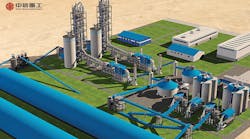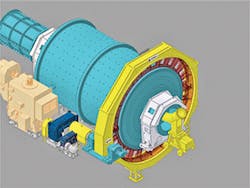Pictures and models have been used to design every type of costly and complex construction throughout human history. More recently, increasingly dynamic simulations and digital twin software are processing data close enough to real-time to also optimize assets and operations.
For instance, to transform China’s building materials manufacturing industry, Fujian Ansha Jianfu Cement Co. in Yongan, Fujian, China, recently started building a new, green/sustainable, smart cement factory with a daily production capacity of 4,500 tons. The almost $136 million project required design and layout of its entire equipment system, as well as integrating various process parameters and data related to equipment operations to achieve intelligent plant management.
As a leading cement industry equipment and solutions supplier, Citic Heavy Industries Ltd. in Beijing was contracted to provide overall engineering design, procurement, construction and delivery of the new factory. This large-scale, full-process cement manufacturing project included working with multiple engineering disciplines, which presented coordination and technical challenges. In addition, Citic reports it soon learned that conventional design and construction methods wouldn't accommodate the construction and delivery of Fujian Ansha's smart, energy-efficient factory.
Beyond conventional design
To achieve a breakthrough in delivering a greener, energy-efficient cement plant, Citic's engineers had to consider several factors at once, including equipment design, construction management, factory operations and monitoring processes. They report that they pushed the boundaries of traditional design methods to achieve "process automation by design," which leverages visualization and digitalization technologies to bring intelligence to large-scale equipment. They add they wanted to build a digital plant by synchronizing design, construction, delivery and operations with the physical plant through 3D parametric equipment design and digital-twin technology. A parametric approach to creating models means engineers set clear parameters, features and relationships for their models, which are intended to capture the behavior of a device or system.
“We needed to deliver a parametric equipment design system, green cement factory system, and an intelligent cement plant system,” says Ruan Jian, building information modeling (BIM) director of the Innovation Institute at Citic. To achieve its deliverables, the company needed a cloud-based, collaborative platform and integrated, BIM applications to coordinate multidiscipline designs, generate equipment models, and incorporate artificial intelligence (AI) and the Internet of Things (IoT) to maximize data potential for the cement plant's lifecycle operations.
To leverage 3D BIM and digital twin technology, Citic decided to implement collaborative BIM technology from Bentley Systems to integrate 3D parametric design of the main equipment, perform construction simulation, and generate a full-process, green cement plant with intelligent controls (Figure 1). “We used Bentley software for the whole collaborative design and construction processes for intelligent delivery of the project,” adds Jian. Citic also selected Bentley's OpenBuildings and OpenPlant software for process design, civil engineering and equipment modeling.
Figure 2: Citic implemented BIM at Fujian Ansha's cement plant in conjunction with its cloud platform and Bentley's iTwin cloud service to integrate process data, produce 3D models, and visually monitor and manage equipment and operations, such as roller-bearing surfaces, ball mill design, particle sizes after cracking, and finished product quality predictions. This solution reduced design changes by 80% and design time by one month; saved three months of construction time and $3 million; reduced equipment maintenance by $2 million; annually saves 3.5 million kilowatt hours (kWh); and is expected to save the plant $1.24 million per year. Source: Citic and Bentley
"Citic provided the main equipment for this cement plant, and wanted to deliver a facility designed to be controlled and operated from its the design model, so optimum energy consumption could be achieved, making it a smart, green cement plant," says Anne-Marie Walters, industry marketing director for oil and gas and manufacturing at Bentley. "They used a parametric design and modeling approach integrated with the plant's control system to do it. Traditional design and construction builds the plant and adds controls later. This plant was designed to be controlled by its design/engineering and BIM model."
Citic also developed a 3D parametric equipment design system to meet rapid design needs and accommodate different design specifications. It also used Bentley's ProjectWise software for its collaborative engineering platform, and created a 3D digital design and construction management system. This system enabled Citic to visualize and synchronize design modeling and construction, and streamline workflows to avoid design collisions. The cement equipment builder adds it almost completely eliminated onsite construction errors and associated costs, and reduced material waste to protect the local environment.
"ProjectWise manages the information that gets sent to construction to build the plant," says Walters. "The information in the parametric building information model is linked to the control systems to operate the plant."
Digitalization for smarter delivery
By using Bentley’s BIM applications in a connected data environment with its iTwin cloud-based processing services that display iModels from the original design applications, Citic also established a digital twin to visually manage equipment and integrate process data related to equipment operations at Fujian Ansha. This process facilitates online, intelligent equipment monitoring and diagnostic services, and establishes a preventive maintenance system that enhances operational safety and improves equipment reliability. Through Bentley’s integrated, cloud-based applications, Citic produced accurate 3D models of the cement plant's main equipment, and can now digitally monitor plant equipment and processes, achieving whole lifecycle BIM management from design through delivery and operations.
"In this case, Citic is integrating its own cloud services that manage equipment operation with iTwin technology to link in the engineering/design models," explains Walters.
Citic reports that it designs its main equipment with Bentley's parametric design software, which introduces equipment health management and central control XSOM system functions. Combining with Citic's cloud services and IoT technology, this central control platform uses BIM to visually run the equipment management system; integrate various process parameters and process data related to equipment operation; and provide intelligent equipment monitoring and diagnostic services by updating big data going to Citic's cloud service.
As a result, Citic created 3D models that it can use to monitor devices and processes, and even facilitate process controls. The company reports that deploying BIM, Internet links, big data and the cloud let users at Fujian Ansha track key cement production parameters and equipment performance. This includes monitoring wear and tear of self-aligning roller-bearing surfaces, ball mill design, particle sizes after cracking, exhaust gas detection and analysis predictions, soft measurements, and finished product quality predictions. Citic adds that remote teams can carry out maintenance management and failure equipment predictions. This includes providing solutions for operations and maintenance as soon as possible in combination with an online management system of spare parts and equipment that also resides on Citic's cloud, and ensures rapid supply of components to avoid losses caused by maintenance and shutdown.
Breaking through to savings
By implementing Bentley’s open-BIM applications, Citic report it achieved a breakthrough from traditional 2D design methods to 3D parametric design and 4D construction monitoring, and industrialized the delivery of Fujian Ansha’s energy-efficient cement factory. Establishing digital collaborative engineering workflows streamlined multidiscipline design, enhancing modeling accuracy and enabling early collision detection that reduced design changes by 80% and design time by one month. Specifically, the collision conflicts among civil engineering and electrical installation during construction were reduced to zero. By creating a digital construction and management platform within a connected data environment, Citic automated previously manual processes, such as reducing formerly large numbers of drawings that need to be manually checked. This digitalization improved work efficiency, and saved three months of construction time and $3 million in project costs. Furthermore, the accurate 3D equipment design models reduced equipment costs by 1.5% and enabled pre-installation of equipment prior to factory shipping, and shortened onsite assembly time by one third.
In addition, using iTwin to generate a digital twin, Citic linked the 3D equipment model with intelligent digital data processes, enabling visual monitoring of the cement production process to save over 30% in operations and maintenance costs. By digitalizing equipment management processes, they were able to predict equipment failure and quickly provide operations and maintenance solutions. Via an online management system for spare parts, Citic could rapidly supply necessary equipment components to clients for the first time, avoiding losses caused by factory maintenance or shutdowns. By using digital twins, the company implemented a preventive asset maintenance system that reduced equipment maintenance costs by $2 million, compared to a planned, reactive asset management process. Citic expects the digital intelligent, green factory manufacturing processes to reduce annual electricity consumption by 3.5 million kilowatt hours (kWh). Overall, these processes are expected to save Fujian Ansha about $1.24 million per year.
“3D parametric equipment design has made a breakthrough in the design automation of equipment, while digitalization has added an intelligent brain to large-scaled mining equipment,” says Jiang Huimin, associate dean at Citic. “The application of Bentley’s full-discipline software is able to realize positive design of an intelligent, green cement factory.”







